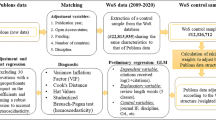Abstract
In academia, citations received by articles are a critical metric for measuring research impact. An important aspect of publishing in academia is the ability of the authors to navigate the review process, and despite its critical role, very little is known about how the review process may impact the research impact of an article. We propose that characteristics of the review process, namely, number of revisions and time with authors during review, will influence the article’s research impact, post-publication. We also explore the moderating role of the authors’ social status on the relationship between the review process and the article’s success. We use a unique data set of 434 articles published in Marketing Science to test our propositions. After controlling for a host of factors, we find broad support for our propositions. We develop critical insights for researchers and academic administrators based on our findings.
Similar content being viewed by others
Notes
Data was available in days, but we used months for ease of representation of the scale of the coefficients.
The results from this robustness analysis are available upon request.
References
Azar OH (2004) Rejections and the importance of first response times. Int J Soc Econ 31(3):259–74
Bakanic V, McPhail C, Simon RJ (1987) The manuscript review and decision-making process. Am Sociol Rev 52(5):631–42
Baumgartner H, Pieters R (2003) The structural influence of marketing journals: a citation analysis of the discipline and its subareas over Tim. J Mark 67(April):123–39
Benda WGG, Tim C, Engels E (2011) The predictive validity of peer review: a selective review of the judgmental forecasting qualities of peers, and implications for innovation in science. Int J Forecast 27(1):166–82
Bergh DD, Perry J, Hanke R (2006) Some predictors of SMJ article impact. Strateg Manag J 27(1):81–100
Bessen J, Maskin E (2009) Sequential innovation, patents, and imitation. RAND J Econ 40(4):611–35
Beyer JM, Chanove RG, Fox WB (1995) The review process and the fates of manuscripts submitted to AMJ. Acad Manage J 38(5):1219–60
Black N, van Rooyen S, Godlee F, Smith R, Evans S (1998) What makes a good reviewer and a good review for a general medical journal? JAMA 280(3):231–33
Carpenter MA (2009) Editor’s comments: mentoring colleagues in the craft and spirit of peer review. Acad Manage Rev 34(2):191–95
Cole S, Simon G, Cole JR (1988) Do journal rejection rates index consensus? Am Sociol Rev 53(1):152–56
Cooper RG (2008) Perspective: the stage gate® idea to launch process—update, what’s new, and NexGen systems. J Prod Innov Manag 25(3):213–32
DeSarbo WS, Jedidi K, Sinha I (2001) Customer value analysis in a heterogeneous market. Strateg Manag J 22(9):845–57
Grewal R, Lilien GL, Mallapragada G (2006) Location, location, location: how network embeddedness affects project success in open source systems. Manag Sci 52(7):1043–56
Hinds PJ, Bailey DE (2003) Out of sight, out of sync: understanding conflict in distributed teams. Organ Sci 615–32
Horrobin DF (1990) The philosophical basis of peer review and the suppression of innovation. JAMA 263(10):1438
Kassirer JP, Campion EM (1994) Peer review: crude and understudied, but indispensable. JAMA 272(2):96–97
Kronick DA (1990) Peer review in 18th-century scientific journalism. JAMA 263(10):1321
Lehmann DR (2005) Journal evolution and the development of marketing. J Public Policy Mark 24(1):137–42
Lewis MW, Welsh AM, Dehler GE, Green SG (2002) Product development tensions: exploring contrasting styles of project management. Acad Manage J 45(3):546–64
Mallapragada G, Grewal R, Lilien G (2012) User-generated open source products: founder’s social capital and time to product release. Mark Sci 31(3):474–92
McLachlan GJ, Peel D (2000) Finite mixture models. Wiley, New York
Medoff MH (2003) Collaboration and the quality of economics research. Labour Econ 10(5):597–608
Merton RK (1957) Priorities in scientific discovery: a chapter in the sociology of science. Am Sociol Rev 22(6):635–59
Merton RK (1961) Singletons and multiples in scientific discovery: a chapter in the sociology of science. Proc Am Philos Soc 105(5):470–86
Rooyen V, Susan FG, Evans S, Smith R, Black N (1998) Effect of blinding and unmasking on the quality of peer review: a randomized trial. JAMA 280(3):234–37
Schoonhoven CB, Eisenhardt KM, Lyman K (1990) Speeding products to market: waiting time to first product introduction in new firms. Adm Sci Q 35(1)
Simonton DK (2002) Great psychologists and their times: scientific insights into psychology’s history. Am Psychol Assoc
Smith PG (1999) From experience: reaping benefit from speed to market. J Prod Innov Manag 16(3):222–30
Stremersch S, Verhoef PC (2005) Globalization of authorship in the marketing discipline: does it help or hinder the field? Mark Sci 24(4):585–94
Stremersch S, Verniers I, Verhoef PC (2007) The quest for citations: drivers of article impact. J Mark 71(3):171–93
Swaminathan V, Moorman C (2009) Marketing alliances, firm networks, and firm value creation. J Mark 73(5):52–69
Tellis GJ, Chandy RK, Ackerman DS (1999) In search of diversity: the record of major marketing journals. J Mark Res 36(February):120–31
Author information
Authors and Affiliations
Corresponding author
Rights and permissions
About this article
Cite this article
Mallapragada, G., Lahiri, N. & Nerkar, A. Peer Review and Research Impact. Cust. Need. and Solut. 3, 29–41 (2016). https://doi.org/10.1007/s40547-015-0060-1
Published:
Issue Date:
DOI: https://doi.org/10.1007/s40547-015-0060-1




